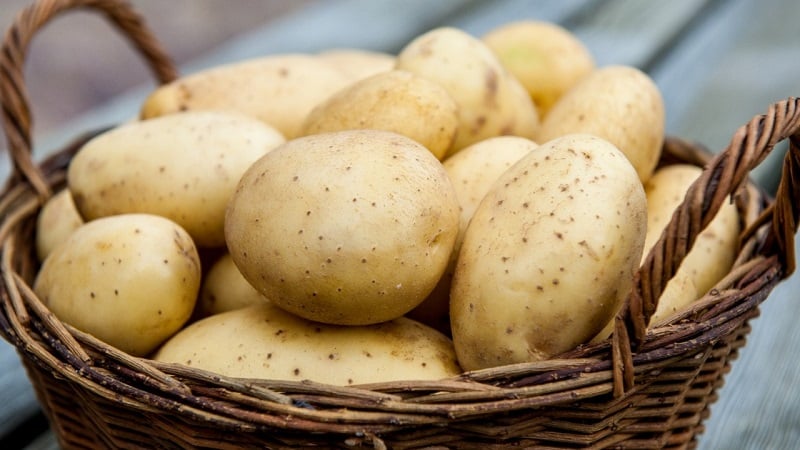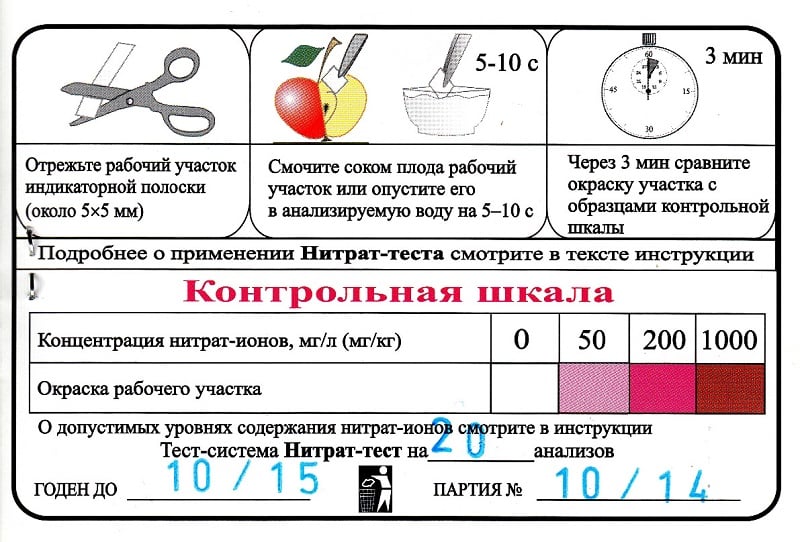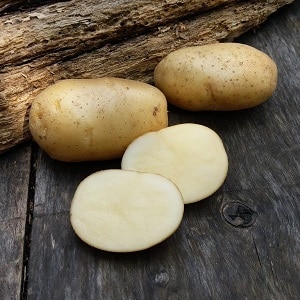Buying harmless vegetables: how to test potatoes for nitrates at home and why this is needed
Vegetables and fruits are the basis of a healthy diet. This is a source of vitamins, minerals, nutrients necessary for the body, a means of preventing cancer, pathologies of the cardiovascular and digestive systems. However, when purchasing, you need to pay attention not only to appearance, but also to quality. If a product looks appetizing and attractive, this does not mean that it does not contain harmful substances.
It turned out that even the most popular root vegetable - potatoes - is unsafe and may contain nitrates. In this article we will tell you how to test potatoes for nitrates at home, why these substances are dangerous to the body, and how to choose high-quality potatoes.
Why is the nitrate content in potatoes dangerous?
What are nitrates and where do they come from? Nitrates are salts and esters of nitric acid, components of mineral fertilizers. Plant nitrogen is usually taken from the soil; it is needed to form chlorophyll, a vital component for plants.

If you fertilize the soil with nitrogen-containing substances, the potato yield will increase sharply, but root vegetables will accumulate it in themselves beyond the norm. The concentration of nitrates is influenced by climatic, seasonal and weather conditions, soil properties and composition, methods of protecting plants from diseases and pests, harvesting and storage conditions.
For reference. The accumulation of nitrates is facilitated by sudden changes in temperature, cool rainy weather, wet swampy soil, acidic or over-limed black soil, and untimely application of fertilizers.
Excess nitrates are toxic to humans: Nitrates are converted into nitrites and nitrosamines in the body. Nitrites turn into nitric oxide and promote dilation of blood vessels, but nitrosamines are highly toxic compounds. They affect the liver, causing hemorrhages, hypoxia, muscle contraction, sometimes accompanied by a short-term loss of consciousness. Most of them have pronounced carcinogenic properties - they increase the likelihood of malignant tumors.
Exceeding the permissible limits of nitrates can cause food poisoning, the manifestations of which will be nausea, vomiting, abdominal pain, diarrhea. Simultaneously with intoxication, body temperature rises to 39°C, muscle pain and headache are felt. Loss of fluid through vomiting and stool leads to dehydration.
Take note:
Mid-late potato variety Charodey

Permissible contents in the composition
Science has determined norms for nitrate content in potatoes and potato products - 250 mg/kg. However, these standards are not a guarantee of health safety. It all depends on how much nitrate-containing food you eat. A norm of 500 mg of nitrates per day is considered acceptable, and already 600 mg is considered toxic.
How to identify potatoes with nitrates
Even when choosing fresh and attractive-looking potato roots, you cannot be sure that they will be healthy and that there will not be a nitrate product on the table.Therefore, it is advisable to eat potatoes that were grown independently without the use of “chemicals” or in guaranteed safe conditions.
If you purchase root vegetables at the market or store, it is important to evaluate their quality, paying attention to organoleptic properties and storage conditions.
For reference. The benefits of young potatoes are exaggerated, and they can also be dangerous. The vegetable is not fully ripe and continues to grow; nitrogen metabolism inside the tubers is high, therefore the nitrate content is too high. As storage proceeds, the level of nitrates decreases and they turn into nitrogenous compounds that are safe for the human body.

By appearance
When buying potatoes, pay attention to the appearance of the root vegetables. If there are green areas in the tubers, then the concentration of toxic solanine in them is much higher. When cleaning, such areas must be removed and the potatoes subjected to longer heat treatment.
Advice. Choose medium-sized root vegetables. Large ones may be oversaturated with nitrates, while small ones have not had time to grow and ripen.
It is not recommended to buy root vegetables with black spots - most likely, the tubers are sick with late blight. Potatoes are often attacked by a wireworm; it bites into the tuber, making passages into which fungi and bacteria then penetrate, causing rot. Potatoes with round holes on the tubers cannot be used for food.
Pay attention to storage conditions. The fruits should be placed in special trays at least 20 cm high and protected from the sun, since under direct rays a toxic substance, solanine, is formed in them.
Read also:
Mid-early table potato variety "Romano"
Unique in appearance and excellent in taste, the Picasso potato variety
Using a nitrate meter
A nitrate meter will help control the quality of vegetables and fruits, including potatoes. This the device determines the presence and concentration of hazardous substances in products.
The principle of operation is simple. The device is programmed with an expanded list of products and nitrate content standards; just select the desired product.

Check the vegetable by piercing the tuber with a probe, which is located at the bottom of the device. If, as a result of the measurement, the screen turns green - the nitrate content is normal, yellow - a slight excess of the norm, red - nitrate substances are in excess, the product is dangerous and unsuitable for consumption.
Reference. Manufacturers allow an error of 15%, which is associated with the uneven distribution of nitrates in fruits.
Using test strips
Indicator strips are designed to determine nitrates in tubers potatoes at home. The fruits are cut lengthwise into two equal parts, a strip is inserted between the halves and pressed tightly. After 10-15 seconds, remove the strip and compare the resulting shade with the color palette on the instructions.
Red-violet color indicates a high concentration of harmful substances - These potatoes should not be consumed.

Traditional methods for checking the nitrate content in potatoes
Traditional methods are less informative and reliable, but to some extent will help check potatoes for harmful compounds:
- Nitrate root vegetables appear to have an unnaturally even shape.
- To determine the presence of nitric acid salts, you will need potato juice and a solution of diphenylamine in sulfuric acid. Freshly squeezed vegetable juice is poured into a test tube and a few drops of diphenylamine solution are added.If the product accumulates harmful substances beyond measure, the reagent turns blue.
- After cutting the potatoes, pay attention to the flesh. The nitrate pulp will ooze water and dampness contained in the tubers. Ecologically clean potatoes are elastic: if you cut them, you hear a crack and juice is released.
Tips and tricks for choosing
Vegetable growers share valuable tips and tricks on how to choose organic potatoes and reduce the content of harmful substances, pesticides and nitrates:
- You should not buy new potatoes before May-June. The biological period of vegetable ripening in nature is August-September. If you purchase early varieties, there is a high probability of getting a product generously loaded with nitrates.
 Removing the peel to a depth of more than 1 cm and prolonged heat treatment reduces the content of nitrate substances and makes the fruit edible.
Removing the peel to a depth of more than 1 cm and prolonged heat treatment reduces the content of nitrate substances and makes the fruit edible.- You can reduce the concentration of nitrates if, before cooking, soak the peeled root vegetables in cold water for half an hour and change it twice. However, such actions wash away starch and other substances useful to the human body along with nitrates.
- Do not buy damaged or cut potato tubers.
- Green potato tubers are unsuitable for consumption because they contain solanine. For plants it serves as protection against damage by bacteria and some types of insects; for the human body it can be toxic. Poisoning is possible after eating unpeeled and unheated potatoes.
- Ask the seller for a certificate of the State Sanitary and Epidemiological Supervision or other documents certifying the quality of the vegetable.
- If it is easy to damage the skin with a fingernail, it means that such potatoes were grown on nitrogen and mineral fertilizers.
- If potato tubers have dried out, shriveled and become soft during long-term storage, stop using this product, since the concentration of solanine in it exceeds permissible standards and is toxic to the human body.
Conclusion
Buying tasty and healthy potatoes is not as easy as it seems. Fruits may contain not only vitamins and minerals valuable to the body, but also toxic compounds. There are practically no side effects from taking acceptable doses of nitrates. When consumed in large portions, they can cause food poisoning, hypoxia, liver dysfunction, and provoke hemorrhages and convulsions.
There are different ways to determine the nitrate concentration in potatoes. The simplest and most reliable are nitrate meter or test strips; alternatively, organoleptic properties and external signs. Methods for detecting harmful compounds will protect you from purchasing a low-quality and dangerous product.
Instructive, intelligible..., but it’s not clear how to distinguish the secreted water and dampness from the secreted juice!?